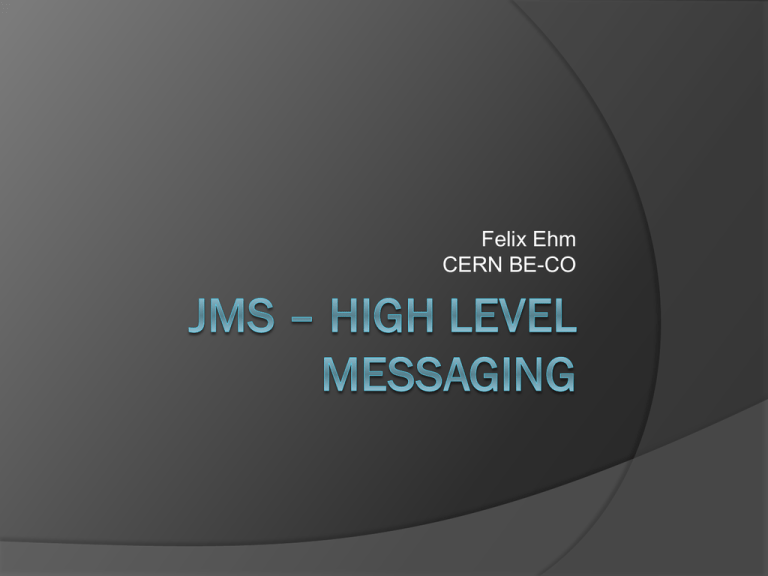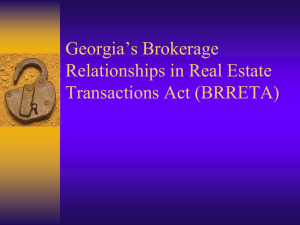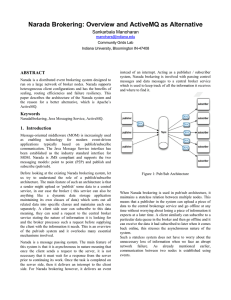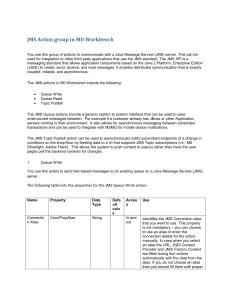JMS as Middleware for CERN*s ACCELERATOR CONTROL SYSTEM
advertisement

Felix Ehm CERN BE-CO Content Introduction JMS in the Controls System Deployment and Operation Conclusion Introduction to JMS – The API Java Messaging Service Messaging API defined in 2002 Decouples Source and Destination Topic / Queue Concepts for named Destinations Introduction to JMS – A Broker Technology originated from the financial sector “Few” sources and large set of readers A Broker is the central entity Accepts messages from 1..* publisher and Broker re-distributes to 0..* subscribers Provides Quality of Service for Messages ○ Persistency, Transactions, Buffering, Expiration Policies, Slow Client Handling Design to distribute data reliably and scalable Load balancing / fail-over / embedded deployment scenarios possible Introduction to JMS - A Broker Many broker implementations available Proprietary IBM WebsphereMQ, SonicMQ, TIBCO, RedHat MRG, … OpenSource Apache ActiveMQ, Apache Apollo, RabbitMQ, HornetMQ, … Broker may be implemented in another language than Java (e.g. Qpid & RabbitMQ) Communication protocol is non-standard Brokers of different vendors are not interoperable AMQP & STOMP address this issue Introduction to JMS - Request/Reply “Direct communication” via Broker using Request – Reply mechanism Requestor sends creates Broker Request MSG Request Queue Temporary Reply Queue Replier Reply MSG sends Due to intermediate Broker two hops are required Introduction to JMS - Selectors Each message can be enriched CYCLE=A TIME=9845 with Attributes Subscriber receives filtered messages via defined selector Broker BUILDING=A BUILDING=B BUILDING=C Topic/ Queue BODY selector: BUILDING ≠ A Subscriber JMS Message Filter messages from one Destination using Messages Selectors HEADERS Introduction to JMS - Persistency JMS defines persistent and non-persistent messages 1. send Broker stores message to Sender disk before acknowledging 2. store 3. ack to sender Avoids loss of data when broker crashes Drawbacks Higher disk load Slower message processing CERN’s Accelerator Complex CERN’s Accelerator Complex JMS in the Controls System Purpose Reliable transport of data between (Java) Processes High level controls applications + middle tier servers ○ Alarm System ○ Data Rendering Services ○ (Control) GUIs ○ Logging Services ○ Beam Security System(s) ○ Access Systems, …. No JMS No Beam ! Today vital part of Beam Operations Product choice: JMS in the Controls System - History History SonicMQ since 2001 for CERN’s Alarm and CO Monitoring system OpenSource ActiveMQ since 2005 ○ Middle tier servers update GUIs ○ Middle tier to Middle tier Phased out in 2013 JMS for Accelerator Controls Early days only Java clients via JAPC japc-ext-remote contains JMS communication Today multi-language clients JAPC clients remain Java using ActiveMQ client libraries directly C++/Python using STOMP Deployment and Operation 29 production brokers Single or broker cluster Large spectrum of usage patterns from few topics to 40K topics from few subscribers to >23 K subscribers from couple msg / minute to 10K msg / sec from few bytes/msg to 3 Mbyte/msg Deployment and Operation Some numbers : 300 Applications 4’400 Connections 40’000 Subscriptions 85’000 Topics 8 Million msg/h IN, 3.5M msg/h OUT Archived Uptime in 2012: 99.998% Not all data which is produced is also consumed Deployment and Operation Distribute Load Interconnect two Brokers Consumers/Producer can choose any Broker Sharing of work Smooth Upgrades possible Client library version != Broker version OK Drawbacks Consumer might not get all messages in case of network error Routing overhead The STOMProtocol The STOMProtocol Simple Text Oriented Message Protocol Defines messaging API + wire format Many open source clients libraries available Python, C/C++, Java, Perl, Ruby, PHP, Erlang, … Targets the messaging interoperability among language, platforms and brokers Supported by many brokers Very easy to use Example to send STOMP in Python mysocket = socket.socket(socket.AF_INET,socket.SOCK_STREAM) mysocket.connect( ("jms-co-dev", 61680) ) text = '''SEND\n\ destination:/queue/CERN.DEPLOYMENT\n\ HOST:%s\n\ INSTALLPATH:%s\n\ PRODUCT:%s\n\ TIME:%s\n\ persistent:false\n\n\x00''‘ mysocket.sendall(text) mysocket.sendall("DISCONNECT\x00") mysocket.close() The AMQProtocol The AMQProtocol Advanced Message Queue Protocol Defines messaging API + wire format Next evolution after JMS Consortium of RedHat, Credit Suisse, Microsoft, JPMorgen, Barclays, VMWare, Cisco, … Released as Version 1.0 More and more brokers implement it Direction for the future ? Conclusion JMS is vital part of Accelerator Controls System Performs very well for publish - subscribe scenarios ActiveMQ was a good choice Running reliably Low maintenance and flexible deployments Provides many metrics for diagnostic and monitoring Multi-language applications can use service Central (redundant) service Result Example Messages received/sec over time AVG Messages / sec time Result Example Histogram of delayed message distribution # Messages Delay time [msec] Result Example Number of “late” (>300ms) messages for test duration Delayed Messages time Message Delay Summary Measuring delayed Message ~ 99.32% of messages delivered < 300ms Rest < 1 sec Doubling numbers of messages (~9500 msg/sec) 100% between 5 and 10 seconds Further studies for improvement needed Result Example CPU load Consumer disconnects % CPU load Consumer connects time 40% less CPU load thanks to optimization Broker Memory Consumption Initial Memory is proportional to Connections Subscriptions 1000 Subscription / Connection 500 Subscriptions / Connection 400 800 350 700 300 600 250 500 200 400 150 300 100 200 50 100 0 0 0 5000 10000 Heap Memory Usage 20000 30000 Live Threads 40000 0 10000 20000 Heap Memory Usage 40000 60000 Live Threads 80000










